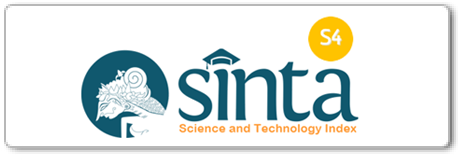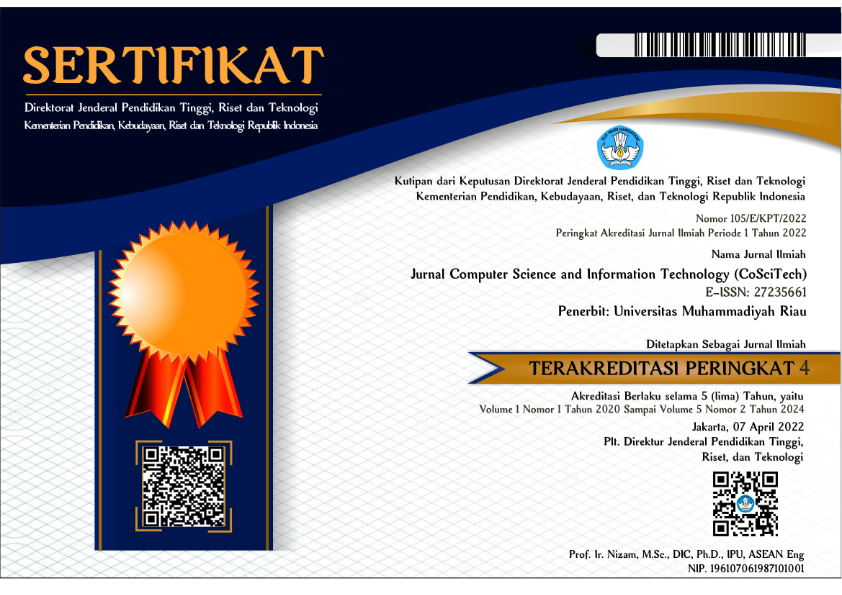A Application of the equivalence class transformation (eclat) algorithm in searching for adverse events for the drug simvastatin
DOI:
 https://doi.org/10.37859/coscitech.v4i3.6381
https://doi.org/10.37859/coscitech.v4i3.6381
Abstract
Cholesterol is a type of fat that circulates in the bloodstream and has an important role in body functions. However, excess cholesterol levels can cause various problems in the body that interfere with the heart, blood vessels, and brain systems. Simvastatin is a lipid-lowering drug in the blood that can reduce cholesterol. In this study, an adverse event was conducted which is an unwanted event in the world of health in the consumption of simvastatin drugs using the Equivalence Class Transformation (ECLAT) algorithm. The data used came from the Food and Drug Administration (FDA) which amounted to 22560 data. Data is managed by the Knowledge Discovery in Databases (KDD) process which goes through several stages, namely data selection, data processing, data transformation, and data mining. Test results are measured based on the lift ratio value which aims to measure the validity of the resulting rule. The test was conducted using a minimum support value of 0.001 and obtained the best lift ratio value of 886.00. In the combination of 2 items, the best rule is "if the duration of therapy is 98 months, it results in acute kidney injury" from 1451 rules with a processing time of 2.70 seconds. The combination of 3 items produces 39 rules with a processing time of 4.46 seconds with the best rule being "if the duration of therapy is 142 months and indicated ill-defined disorder then results in increased blood creatine". The combination of 4 items only produced 18 rules with the best rule being "if sex f, duration of therapy < 1 month and indicated abnormal coronary arteriogram then resulted in anaphylactic shock" in a processing time of 3.45 seconds.
Downloads
References
[2] F. Sijabat, Y. G. Tarigan, and T. Sitanggang, “Peningkatan Pengetahuan Masyarakat Tentang Penggunaan Obat Yang Baik Dan Benar Melalui Gerakan Masyarakat Cerdas Menggunakan Obat (Gema Cermat),” J. Abdimas Mutiara, vol. 2, no. September, pp. 94–109, 2021.
[3] Nurhidayah, “Penggunaan Obat Simvastatin Pasda Pasien Kolesterol Di Puskesmas Dukuhturi,” Politek. Harapan Bersama, p. Kompas 13 September 2017, 2017.
[4] A. Mulyanto, F. P. Annisa, and T. A. Sudarsono, “Comparison Results of Hemoglobin Checkup in Pregnant Women using Cyanmethemoglobin Method and Azidemet Hb Methods,” Biomedika, vol. 15, no. 1, pp. 25–30, 2022, doi: 10.31001/biomedika.v15i1.1204.
[5] Fahreza, D. Hasni, A. T. Vani, and S. N. Jelmila, “Gambaran Kadar Total Kolesterol Pada Pasien Prolanis Yang Mendapat Terapi Simvastatin Di Puskesmas Air Dingin 2018,” Ibnu Sina J. Kedokt. dan Kesehat. - Fak. Kedokt. Univ. Islam Sumatera Utara, vol. 19, no. 2, pp. 53–62, 2020, doi: 10.30743/ibnusina.v19i2.37.
[6] A. Pebiansyah et al., “Edukasi Penyakit Kolesterol dan Penggunaan Obat Simvastatin di Kecamatan Rancah Kabupaten Ciamis,” J. Mandala Pengabdi. Masy., vol. 4, no. 1, pp. 85–90, 2023, doi: 10.35311/jmpm.v4i1.155.
[7] F. C. Kusumasari, “Pengaruh Perbandingan Obat-Polimer terhadap Karakteristik Fisik Mikrokapsul Simvastatin,” vol. 9, no. 1, pp. 111–118, 2023, doi: 10.35311/jmpi.v9i1.316.
[8] E. Pose et al., “Safety of two different doses of simvastatin plus rifaximin in decompensated cirrhosis (LIVERHOPE-SAFETY): a randomised, double-blind, placebo-controlled, phase 2 trial,” Lancet Gastroenterol. Hepatol., vol. 5, no. 1, pp. 31–41, 2020, doi: 10.1016/S2468-1253(19)30320-6.
[9] D. E. Kaplan et al., “SACRED: Effect of simvastatin on hepatic decompensation and death in subjects with high-risk compensated cirrhosis: Statins and Cirrhosis: Reducing Events of Decompensation,” Contemp. Clin. Trials, vol. 104, no. February, p. 106367, 2021, doi: 10.1016/j.cct.2021.106367.
[10] F. A. E. Fardianto, F. Yanto, I. Iskandar, and Pizaini, “Kombinasi algoritma kriptografi vigenere cipher dengan metode zig-zag dalam pengamanan pesan teks,” J. CoSciTech (Computer Sci. Inf. Technol., vol. 4, no. 1, pp. 182–192, 2023, doi: 10.37859/coscitech.v4i1.4787.
[11] Z. Yue, a J. Shi, b H. Li, and H. Lia, “Hubungan antara Penggunaan Asiklovir atau Valasiklovir Secara Bersamaan dengan NSAID dan Peningkatan Risiko Cedera Ginjal Akut: Penambangan Data Sistem Pelaporan Kejadian Buruk FDA,” Biol. Farm. Banteng, vol. 41, pp. 158–162, 2018.
[12] X. Zhang, Y. Tang, Q. Liu, G. Liu, X. Ning, and J. Chen, “A fault analysis method based on association rule mining for distribution terminal unit,” Appl. Sci., vol. 11, no. 11, pp. 1–14, 2021, doi: 10.3390/app11115221.
[13] A. G. Shaaban, M. H. Khafagy, M. A. Elmasry, H. El-Beih, and M. H. Ibrahim, “Knowledge discovery in manufacturing datasets using data mining techniques to improve business performance,” Indones. J. Electr. Eng. Comput. Sci., vol. 26, no. 3, pp. 1736–1746, 2022, doi: 10.11591/ijeecs.v26.i3.pp1736-1746.
[14] A. M. Abdulkadium, R. A. A. Shekan, and H. A. Hussain, “Application of Data Mining and Knowledge Discovery in Medical Databases,” Webology, vol. 19, no. 1, pp. 4912–4924, 2022, doi: 10.14704/web/v19i1/web19329.
[15] M. Man and M. A. Jalil, “Frequent itemset mining: Technique to improve ECLAT based algorithm,” Int. J. Electr. Comput. Eng., vol. 9, no. 6, pp. 5471–5478, 2019, doi: 10.11591/ijece.v9i6.pp5471-5478.
[16] S. Das, A. Dutta, M. Jalayer, A. Bibeka, and L. Wu, “Factors influencing the patterns of wrong-way driving crashes on freeway exit ramps and median crossovers: Exploration using ‘Eclat’ association rules to promote safety,” Int. J. Transp. Sci. Technol., vol. 7, no. 2, pp. 114–123, 2018, doi: 10.1016/j.ijtst.2018.02.001.
[17] M. H. Santoso, “Application of Association Rule Method Using Apriori Algorithm to Find Sales Patterns Case Study of Indomaret Tanjung Anom,” Brill. Res. Artif. Intell., vol. 1, no. 2, pp. 54–66, 2021, doi: 10.47709/brilliance.v1i2.1228.
[18] W. A. W. A. Bakar, M. Man, M. Man, and Z. Abdullah, “i-Eclat: Performance enhancement of Eclat via incremental approach in frequent itemset mining,” Telkomnika (Telecommunication Comput. Electron. Control., vol. 18, no. 1, pp. 562–570, 2020, doi: 10.12928/TELKOMNIKA.V18I1.13497.
[19] S. Evadini, “Analisis Faktor Risiko Kematian dengan Penyakit Komorbid COVID-19 menggunakan Algoritma ECLAT,” J. Inf. dan Teknol., vol. 4, no. 1, pp. 52–57, 2022, doi: 10.37034/jidt.v4i1.181.
[20] A. Widyan and A. F. Rozi, “Analisis Rekomendasi Produk Menggunakan Algoritma ECLAT Berdasarkan Riwayat Data Penjualan PT XYZ,” J. Teknol. Dan Sist. Inf. Bisnis, vol. 3, no. 2, pp. 395–411, 2021, doi: 10.47233/jteksis.v3i2.296.
[21] A. Darmawan and T. Kristiana, “Analisis Pola Penjualan Dengan Menggunakan Algoritma Apriori Pada Koperasi Karyawan Yayasan Anakku,” J. Ris. Inform., vol. 2, no. 1, pp. 31–36, 2019, doi: 10.34288/jri.v2i1.68.
[22] L. Zahrotun, D. Soyusiawaty, and R. S. Pattihua, “The implementation of data mining for association patterns determination using temporal association methods in medicine data,” 2018 Int. Semin. Res. Inf. Technol. Intell. Syst. ISRITI 2018, pp. 668–673, 2018, doi: 10.1109/ISRITI.2018.8864322.














